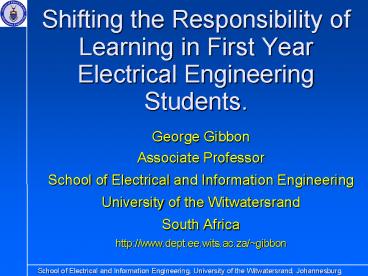Shifting the Responsibility of Learning in First Year Electrical Engineering Students. - PowerPoint PPT Presentation
Title:
Shifting the Responsibility of Learning in First Year Electrical Engineering Students.
Description:
Shifting the Responsibility of Learning in First Year Electrical Engineering Students. George Gibbon Associate Professor School of Electrical and Information Engineering – PowerPoint PPT presentation
Number of Views:113
Avg rating:3.0/5.0
Title: Shifting the Responsibility of Learning in First Year Electrical Engineering Students.
1
Shifting the Responsibility of Learning in First
Year Electrical EngineeringStudents.
- George Gibbon
- Associate Professor
- School of Electrical and Information Engineering
- University of the Witwatersrand
- South Africa
- http//www.dept.ee.wits.ac.za/gibbon
2
Overview
- The students we get (Raw material)
- Support programmes
- Societys requirements
- Problem solving and critical thinking
- How (Electric Circuits)
- Results
3
The raw material
- Clever students (IQ)! (TV/Computer generation)
- Possibly with no engineering aptitude or interest
- Result of Internationalisation of the South
African secondary education system (1994) - Success based on rote learning techniques
- Dependence on teachers for
- Material to be learnt
- Learning techniques
- Examination techniques
- Spotting of examination questions
Students are totally dependent on their teachers,
in a comfort zone, with little imagination, low
self-confidence and no intrinsic-motivation.
4
(No Transcript)
5
The raw material
- Clever students (IQ)! (TV/Computer generation)
- Possibly with no engineering aptitude or interest
- Result of Internationalisation of the South
African secondary education system (1994) - Success based on rote learning techniques
- Dependence on teachers for
- Material to be learnt
- Learning techniques
- Examination techniques
- Spotting of examination questions
Students are totally dependent on their teachers,
in a comfort zone, with little imagination, low
self-confidence and no intrinsic-motivation.
6
Support (Scaffolding) Programmes
- Programmes
- Pre-University Bursary Scheme (1986)
- College of Science
- Engineering Foundation Programme (1994)
- Compulsory Small-group Tutorials (1994)
- Side Effects
- Increased failure rate in third and fourth year
- Increased failure of the design and research
projects in fourth year (Honours year)
7
(No Transcript)
8
Requirements
- Society (ECSA) Engineers must
- Creatively and innovatively identify, assess,
formulate and solve convergent and divergent
problems using - mathematical and numerical analysis
- statistical methods
- physical laws
- techniques and principles of engineering science
- knowledge of the world (financial, ethical,
environmental) - and communicate their results.
- University (Government) Pass more students
without changing standards. - The School Increase throughput and eliminate
failure in the 3rd and 4th years. - Outcome of all University degrees
9
Problem solving requires Self-motivated and
Creative Critical Thinkers
- Identify and challenge all assumptions
- Imagine and explore alternatives
- Emotive as well as rational
- Reject standard formats of problem solving
- Have multiple perspectives on problems
- Use trial-and-error and alternative approaches in
experimentation - Embrace change optimistically
- Self confident and trust in their own judgement
10
Creative Critical Thinking (Brookfield 1987)
- A process not an outcome
- Internal, but usually connected with an
externally imposed crisis. - A productive and positive activity. Discouraged
by - Governments, religious leaders, university and
industry administrations, peers etc. - Cornerstone of democracy
- If a problem already has a solution there is no
problem!! - You cannot teach people problem solving by
providing them with the solution (see 1). (Gibbon)
11
What we decided to do?
- Remove the comfort zone
- (externally imposed crisis)
- Introduce the use of imagination, visualisation
and the fun of exploration - Force self-responsibility
- (intrinsic-motivation)
- Build self-confidence
- (Empower the students)
12
Electric Circuits Critical Thinking
Presented over the whole year 1 formal and 1 informal lecture Externally imposed crisis, imagination, visualisation, exploration
No formal tutorials Externally imposed crisis, intrinsic-motivation
No formal laboratories Imagination, visualisation and exploration
Two self-evaluation take-home tests Intrinsic-motivation, imagination, visualisation, self-confidence
There are no solutions (memos, recipes etc) Externally imposed crisis, imagination, visualisation self-confidence
Two formal tests and an exam.
13
Electric Circuits
- Laboratory 1
- Using the supplied components build the
Amplifier with Gain20 on page 5 of the
attached LM386 data sheet. - Demonstrate the output of the amplifier with an
appropriate input signal supplied to the
microphone. - Attached are laboratory assignments Introduction
to the Oscilloscope and Introduction to the
Digital Multi-meter which may help you to test
the amplifier and demonstrate the output signal.
14
Management of the imposed crisis
- The stages psychologists associate with a loss
- Shock
- Denial
- Strong emotion
- Resistance and withdrawal
- Struggle and exploration
- Return of confidence
- Integration and success.
- Foundation / Special Programmes
15
Small Group Instructional Diagnosis (SGID)
- Students were aware that the more actively they
participated in the course the more likely they
were to have made gains in critical and
independent thinking. - The weakest group, even when pushed by the
interviewer, would not blame the lecturers or the
university for their failures and accepted
responsibility - a very unusual phenomena.
16
Feedback from the Tutors
- Tutors feel at least 80 of the class really know
how to use an oscilloscope.
17
Results Electric Circuits Results 2004
18
Mathematics II
- What had we done to the students?
- For the first time they were
- well behaved
- attentive
- prepared for both the lectures and tutorials
- reading ahead without instructions to do so.
19
In conclusion
- Courses continuing the teaching philosophy
- Engineering Skills and Design Course (1st year)
- Electronics I, Software Engineering I (2nd year)
- Electronics II (3rd year)
- Measurement Systems (4th year)
- The future
- Involve all the staff and service courses
- We are
- Developing the imagination, self-confidence,
intrinsic-motivation, critical thinking and
problem solving skills of our students.

